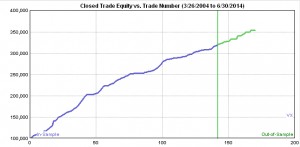I have been working on developing some high frequency spread strategies using Trading Technologies’ Algo Strategy Engine, which is extremely impressive (more on this in a later post). I decided to take a time out to experiment with a slower version of one of the trades, a calendar spread in VIX futures that trades the spread on the front two contracts. The strategy applies a variety of trend-following and mean-reversion indicators to trade the spread on a daily basis.
Modeling a spread strategy on a retail platform like Interactivebrokers or TradeStation is extremely challenging, due to the limitations of the platform and the Easylanguage programming language compared to professional platforms that are built for purpose, like TT’s XTrader and development tools like ADL. If you backtest strategies based on signals generated from the spread calculated using the last traded prices in the two securities, you will almost certainly see “phantom trades” – trades that could not be executed at the indicated spread price (for example, because both contracts last traded on the same side of the bid/ask spread). You also can’t easily simulate passive entry or exit strategies, which typically constrains you to using market orders for both legs, in and out of the spread. On the other hand, while using market orders would almost certainly be prohibitively expensive in a high frequency or daytrading context, in a low-frequency scenario the higher transaction costs entailed in aggressive entries and exits are typically amortized over far longer time frames.
In the following example I have allowed transaction costs of $100 per round turn and slippage of $0.1 (equivalent to $100) per spread. Daily settlement prices from Mar 2004 to June 2010 were used to fit the model, which was tested out of sample in the period July 2010 to June 2014. Results are summarized in the chart and table below.
Even burdened with significant transaction cost assumptions the strategy performance looks impressive on several counts, notably a profit factor in excess of 300, a win rate of over 90% and a Sortino Ratio of over 6. These features of the strategy prove robust (and even increase) during the four year out-of-sample period, although the annual net profit per spread declines to around $8,500, from $36,600 for the in-sample period. Even so, this being a straightforward calendar spread, it should be possible to trade the strategy in size at relative modest margin cost, making the strategy return highly attractive.
(click to enlarge)
(click to enlarge)



